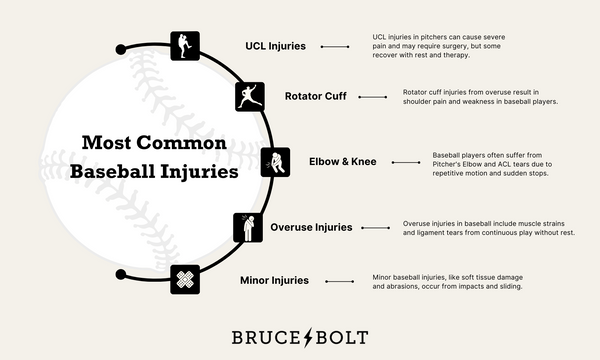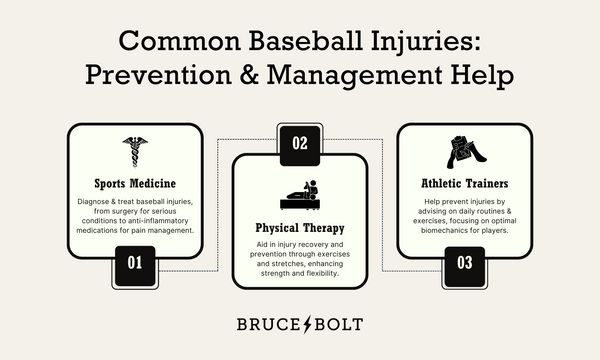Baseball captivates millions of fans and players with its skill, strategy, and compelling gameplay. However, the sport also carries significant potential for injuries. Baseball players, both professionals and young athletes alike, are not strangers to various forms of discomfort, from minor scrapes and bruises to more severe forms of injury. Whether you're a seasoned player in Major League Baseball, a Little League player, or anything in between, understanding the most common baseball injuries can serve as the first step to preventing their occurrence.
Baseball players are especially susceptible to ulnar collateral ligament (UCL) injuries, rotator cuff injuries, elbow and knee injuries, overuse injuries, and other more minor injuries. These issues can stem from repetitive throwing, improper form, lack of effective warmups before matches, or simple accidents during gameplay. In addition to causing immediate pain, these injuries can significantly hinder your performance and growth or even result in a season-ending injury.
Common Baseball Injuries

Ulnar Collateral Ligament (UCL) Injuries
One of the most feared injuries among pitchers is to the UCL, a ligament of the elbow that takes on high stress during the throwing motion. This ligament is often damaged due to repetitive motion and overuse. Once strained or torn, it can lead to severe pain and difficulty in throwing. The most notorious treatment for a severe UCL injury is the famous Tommy John Surgery or UCL reconstruction, named after a former professional baseball pitcher. However, not all UCL injuries lead to surgery. Some can heal over time with sufficient rest and consistent physical therapy.
Rotator Cuff Injuries
Given the intensive nature of the throwing motion, rotator cuff injuries are common in baseball players. The rotator cuff is a group of muscles and tendons that keep the shoulder joint stable. Overuse injury in this area can lead to rotator cuff tendonitis, causing pain and weakness in the shoulder – a major setback for baseball players.
Elbow and Knee Injuries
Another common injury in baseball is known as Pitcher's Elbow, or medial epicondylitis, caused by repetitive throwing. It results in inflammation in the tendons connecting the forearm to the elbow. Knee injuries like ACL tears are also prevalent due to sudden stops or changes in direction required in baseball.
Overuse Injuries
This refers to a broad category of injuries caused by repetitive action without giving the body enough time to heal. These include muscle strains, stress fractures, ligament tears, and more – which are largely the result of the repetitive throwing motion in baseball.
Minor Injuries
Don’t underestimate the smaller risks! Baseball players also face more minor, yet extremely bothersome injuries such as soft tissue injuries from being hit by a pitch and abrasions from sliding into bases.
You may ask, is there a way to prevent these injuries? The answer is absolutely! While we cannot eliminate all risks, we can certainly take steps to reduce their likeliness.
The Importance of Sports Medicine, Physical Therapy, and Athletic Trainers in the Management and Prevention of Baseball Injuries

Sports Medicine
In baseball, the world of sports medicine plays an instrumental role. Practitioners in this field are skilled at diagnosing common baseball injuries and implementing effective treatment plans. From surgical procedures for serious issues like UCL injuries to prescribing anti-inflammatory medication to manage pain and inflammation, a sports medicine physician should be among your first calls following any injury.
Physical Therapy
After speaking with a sports medicine professional they will likely send you to a physical therapist. Physical therapists contribute significantly to not just injury recovery, but prevention as well. Through specialized exercises and stretches, they can help build the strength and flexibility to protect players from overuse injuries. Moreover, in case of a season-ending injury, physical therapists are critical in the rehabilitation process, helping players restore function and enabling them to return to the field safely.
Athletic Trainers
Athletic trainers are employed to guide players in their daily routines, stretches, and strength training exercises that can help promote resistance to injury. They understand the intricate biomechanics of baseball motions and can help players, especially pitchers, optimally distribute stress during throwing, thereby reducing the risk of common shoulder and elbow injuries.
Of course, alongside professional guidance, the right equipment also plays a vital role in injury prevention. In the next section, we’ll look at how BRUCE BOLT's innovative equipment can contribute to safer practices and better performances on the baseball field.
Prevention Techniques and Equipment for Common Baseball Injuries
To further enhance your performance and safety, there are specific prevention techniques and equipment that all baseball players should consider. These will help you mitigate the risks of common baseball injuries and keep you protected during play.
Injury Prevention Techniques
Regularly practicing good throwing form is crucial to safeguarding the shoulder and elbow from injuries. The application of warm-ups and stretches before every game will prepare your muscles for the rigorous exercise, reducing the risk of strains. Moreover, ensuring your body gets adequate rest between games will prevent overuse injuries. For pitchers, limiting pitch count (including in training) can help minimize the stress on your arm. If you only take one thing away from this blog it should be the importance of band stretching every time you throw. These types of band exercises will help you build up strength in critical areas, helping distribute the load put on your shoulder and elbow when throwing.
Protective Gear & Compression Sleeves
High-quality gear is a key part of injury prevention in baseball. Here's where BRUCE BOLT enters the scene. We provide an array of protective equipment like sliding mitts, leg guards, elbow guards, and hand guards. Gear can minimize the pain of getting hit by a pitch or protect your hand when sliding into bases. Beyond protective equipment, our arm sleeves are specifically designed to lessen the strain on your throwing arm, thereby reducing the likelihood of arm injuries.
Can Equipment Protect Me Completely?
While protective gear provides a safety layer, it's crucial to clarify that gear is not a standalone solution. It's simply a powerful tool in your toolbox to complement proper form, strength training, and physical therapy. Having the right gear can provide added confidence and comfort while playing.
Overall, minimizing common baseball injuries involves a holistic approach that combines a well-designed exercise regime, professional guidance, and quality protective gear. As a family-owned company, BRUCE BOLT is committed to helping you protect your game, boost your performance, and increase your enjoyment of baseball.
Around the Horn: Common Baseball Injuries & How to Prevent Them
After discussing the most common baseball injuries, one aspect became abundantly clear — injury prevention and management in baseball require a comprehensive approach and consistent effort.
We learned that encountering injury is not something you have to go about alone. A team of professionals such as sports medicine specialists, physical therapists, and athletic trainers will guide you toward recovery and even help you prevent future injuries. We also recognized that preemptive measures can play a significant role in reducing injuries — suitable warm-ups, band stretches, rest periods, and practicing the correct throwing form.

How BRUCE BOLT Can Help
Integrating quality protective gear into your game routine can add a valuable layer of protection. BRUCE BOLT’s range of high-quality equipment – including protective gear and compression sleeves – is designed to promote safety without compromising performance.
As a baseball player, your primary goal should always be to enjoy the game and play at your best. BRUCE BOLT is committed to backing this goal with the best equipment and informational support. Play safe, and let BRUCE BOLT aid you in your journey towards becoming a safer, better baseball player!
